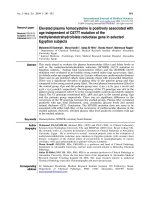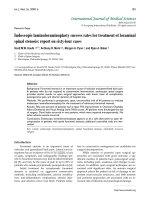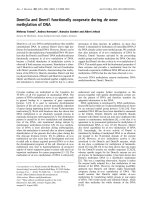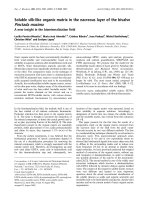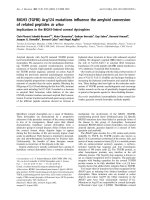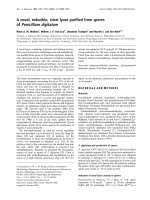Báo cáo y học: "Percutaneous laser disc decompression for thoracic disc disease: report of 10 cases"
Bạn đang xem bản rút gọn của tài liệu. Xem và tải ngay bản đầy đủ của tài liệu tại đây (184.8 KB, 5 trang )
Int. J. Med. Sci. 2010, 7
155
I
I
n
n
t
t
e
e
r
r
n
n
a
a
t
t
i
i
o
o
n
n
a
a
l
l
J
J
o
o
u
u
r
r
n
n
a
a
l
l
o
o
f
f
M
M
e
e
d
d
i
i
c
c
a
a
l
l
S
S
c
c
i
i
e
e
n
n
c
c
e
e
s
s
2010; 7(3):155-159
© Ivyspring International Publisher. All rights reserved
Research Paper
Percutaneous laser disc decompression for thoracic disc disease: report of
10 cases
Scott M.W. Haufe
1,3
, Anthony R. Mork
2,3
,
Morgan Pyne
4
and Ryan A. Baker
4
1. Chief of Pain Medicine and Anesthesiology
2. Chief of Spine Surgery
3. MicroSpine, DeFuniak Springs, FL 32435, USA
4. University of South Florida Medical Student
Corresponding author: Scott M.W. Haufe, M.D., 101 MicroSpine Way, DeFuniak Springs, FL 32435. Phone: 888-642-7677;
Fax: 850-892-4212; Email:
Received: 2010.03.19; Accepted: 2010.05.26; Published: 2010.06.01
Abstract
Background: Discogenic pain or herniation causing neural impingement of the thoracic ver-
tebrae is less common than that in the cervical or lumbar regions. Treatment of thoracic
discogenic pain usually involves conservative measures. If this fails, conventional fusion or
discectomy can be considered, but these procedures carry significant risk.
Objectives: To assess the efficacy and safety of percutaneous laser disc decompression (PLDD)
for the treatment of thoracic disc disease.
Methods: Ten patients with thoracic discogenic pain who were unresponsive to conservative
intervention underwent the PLDD procedure. Thoracic pain was assessed using the Visual
Analog Scale (VAS) scores preoperatively and at 6-month intervals with a minimum of
18-months follow-up. Patients were diagnosed and chosen for enrollment based on abnormal
MRI findings and positive provocative discograms. Patients with gross herniations were not
included.
Results: Length of follow-up ranged from 18 to 31 months (mean: 24.2 mo). Median pre-
treatment thoracic VAS score was 8.5 (range: 5-10) and median VAS score at final follow-up
was 3.8 (range: 0-9). Postoperative improvement was significant with a 99% confidence in-
terval. Of interest, patients generally fell into two groups, those with significant pain reduction
and those with little to no improvement. Although complications such as pneumothorax,
discitis, or nerve damage were possible, no adverse events occurred during the procedures.
Limitations: The study is limited by its small size and lack of a sham group. Larger controlled
studies are warranted.
Conclusions: With further clinical evidence, PLDD could be considered a viable option with a
low risk of complication for the treatment of thoracic discogenic pain that does not resolve
with conservative treatment.
Key words: back pain, minimally invasive surgery, laser, intervertebral disc, spine surgery
Background and objectives
Percutaneous laser disc decompression (PLDD)
is a minimally invasive treatment option for vertebral
disc herniation refractory to conservative treatment.
PLDD was first used in 1986 and received approval
from the U.S. Food and Drug Administration in 1991
(1). Based on the reduced risk associated with less
invasive procedures, PLDD has increased in popular-
ity, with reportedly over 30,000 PLDD procedures
Int. J. Med. Sci. 2010, 7
156
performed in 2001 (2). PLDD is performed under local
anesthesia via a laser fiber percutaneously inserted
into the nucleus pulposus. Laser energy is applied
through the fiber, resulting in vaporization of nucleus
pulposus contents (3).
Improvement in discogenic pain with PLDD is
based upon laser-induced evaporation of water
within the disc; this results in a very slight decrease in
disc size due to water loss. Because the intervertebral
disc is essentially a closed hydraulic system, a small
decrease in volume leads to a significantly larger de-
crease of intradiscal pressure; in vitro experiments
confirm this (4,5). The short term decrease in pressure
is due to evaporation of water content within the
nucleus pulposus; long term effects are thought to be
due to protein denaturation, which limits the ability of
the nucleus to resorb additional water and reduces
stiffness of the disc (3,6,7). This hypothetically results
in a more even distribution of weight across the in-
tervertebral disc (8).
Consistent with a lumbar location for the major-
ity of intervertebral disc herniations, most published
studies have focused on the use of PLDD for the
treatment of lumbar disc disease. Thoracic discogenic
pain or herniation causing neural impingement is less
common than that in the cervical or lumbar regions.
Certain impact injuries, such as parachute landings,
can result in thoracic disc damage. Invasive treatment
of such injuries often involves a thoracotomy proce-
dure with either a discectomy or fusion implantation.
Although many studies have been done on lumbar
and cervical PLDD procedures, few have been done
on the thoracic region. In order to assess the efficacy
and safety of PLDD for the treatment of thoracic disc
disease, we performed a study of ten patients with
thoracic discogenic pain who were unresponsive to
conservative intervention.
Methods
We performed a prospective study of ten pa-
tients (8 male and 2 female) with an age range of 35-73
years. All patients presented with mid-thoracic axial
(n=7) or radicular (n=1) pain that failed to improve
with conservative management, which included typ-
ical modalities such as physical therapy, pain medi-
cation, and epidural steroid injections. Physical ex-
amination revealed localized thoracic pain without
recreation of symptoms with palpation. The pain was
either centralized or radiating to one side. There was
no facet tenderness present. All the patients had neg-
ative facet injections, to evaluate for the possibility of
facet joint pain as the underlying cause. The patients
had positive discograms that correlated to their pain;
in the case of the individual with radicular symptoms,
she had total relief of her pain with a thoracic nerve
root block, confirming this as the source of her pain.
All patients were diagnosed with thoracic discogenic
pain based on MRI and provocative discogram re-
sults. Magnetic resonance imaging (MRI) findings
that were considered abnormal included changes de-
scribed as irregular nuclear shape, reduced disc
height, hypo-intense disc signal, annular tears, high
intensity zones, endplate changes, and Modic changes
(9,10,11).
All patients underwent diagnostic injections to
confirm the source of their pain; these injections in-
cluded either thoracic nerve root blocks for radicular
symptoms and/or provocative discograms (12). The
provocative discograms involved low-pressure injec-
tions of at least three disc levels and one of the levels
was utilized as a control. Thoracic discography has
been utilized as a controversial confirmatory test for
discogenic pain for some time with debatable results
(13,14). Studies show false positive results with dis-
cograms to be as high as 25% (13,15). A recent sys-
tematic review reported the published evidence to be
of low quality (16). The authors identified only two
studies by the same authors for inclusion, each over
10 years old. They recommended that other methods
may be equally effective. Due to the lack of estab-
lished accuracy of discography, we required the
combination of an abnormal MRI and a positive pro-
vocative discogram to diagnose intervertebral discs as
the source of pain and to identify potential study par-
ticipants.
It was felt that gross herniations producing sig-
nificant cord compression would be better treated
with a laminotomy approach, and that not enough
disc material would be removed to resolve the steno-
sis in such situations. Thus only patients with con-
tained disc protrusions were considered for PLDD
and patients with gross herniation were removed
from the study and sent for laminotomy or conven-
tional discectomy.
Patients’ chosen for the procedure reported their
thoracic pain using the Visual Analog Scale (VAS)
pain scores at baseline. Posttreatment, patients were
evaluated every six months via telephone call or di-
rect patient contact for at least 18 months. The patient
was specifically asked to address the pain level of the
thoracic spine region and not the body as a whole.
This was done to eliminate patients with short-term
improvement from introducing bias. A
double-blinded study would have been preferable
with a sham group but was not possible at our facility.
The procedure begins with a properly prepped
and draped patient in the prone position. All patients
received intravenous (IV) antibiotics prior to the pro-
Int. J. Med. Sci. 2010, 7
157
cedure. Cefofloxin was utilized unless there was an
allergy, in which case ciprofloxin was used. Mild se-
dation was used during the procedure and the patient
was able to converse with the surgeon in order to ex-
press any unusual pain. Sedation involved a combi-
nation of benzodiazepines and opiates. Fluoroscopy
was utilized during the procedure for proper count of
the thoracic vertebrae and to determine the entry site.
The entry site was similar in position to a typical tho-
racic discogram and was approximately 3 inches lat-
eral to the midline of the spine. Caution was necessary
due to the lung fields being close to the needle entry
site, increasing the risk of pneumothorax. Once the
entry site was determined, the skin and deeper tissues
were anesthetized with a mixture of 0.25% bupiva-
caine and 1% lidocaine with epinephrine via a
27-gauge needle. A 15 blade was used to create a stab
incision of approximately ¼ inch. Through the inci-
sion, an 18-gauge, 3.5-inch spinal needle was inserted
and the needle was guided into the middle of the disc
using fluoroscopy. Positioning was confirmed via
anterior and lateral x-ray views. Once properly
placed, a direct firing holmium laser (diameter 0.5
mm) at 20 watts and 10 repetitions per second
(6030-10405 Joules, mean 7633) was utilized in short
bursts to vaporize the inside of the disc. In most cases
these burst were of ten second intervals; the patient
usually complained of burning mid back pain which
limited the time per lasing period. After the lasing
periods, the disc was “cooled” with normal saline (at
least 100 ml) mixed with cefazolin (unless there was
an allergy). Saline irrigation was performed after, not
simultaneously with, laser application due to the size
of the diameter of the working environment and be-
cause a running irrigant would reduce the laser's ef-
fectiveness and thus increase operating times. Total
lasing time was approximately 3 minutes, but varied
from 80 seconds to 300 seconds. In most cases, the end
point was when the pressure in the disc was reduced
and injection of the normal saline occurred without
any resistance. At this point the needle was removed
and either the next disc was commenced or the pro-
cedure was finished. Closure involved a single ste-
ri-strip over the incision. No sutures were used. Te-
graderm and 2x2 gauze was placed over the wound.
Results
All ten patients tolerated the procedure well.
There were no complications. Expected possible
complications included those seen with thoracic dis-
cogram and laser usage such as infection or discitis,
pneumothorax, nerve injury, and burn injuries (14).
Each patient had a post procedural chest x-ray to rule
out pneumothorax; no pneumothorax was seen.
Length of follow-up ranged from 18 to 31 months
(mean: 24.2 months). Patients were asked to assess
their thoracic pain via a VAS score preoperatively and
at final follow-up visit. Median VAS score pretreat-
ment was 8.5 (range: 5-10) and median VAS at final
follow-up was 3.8 (range: 0-9). Six of ten patients’
scores improved by at least 6 points; one patient im-
proved by 1 point and three patients’ scores did not
improve. No patients reported worsening of symp-
toms. Results are summarized in Table 1. No side ef-
fects were reported, and no adverse events occurred
during the procedure.
Table 1. Pre- and post-intervention Visual Analog Scale
(VAS) pain scores.
Age Sex Pre-VAS Post-VAS Postoperative pe-
riod at post-VAS
score measurement
61 M 10 9 31 months
44 M 7 7 31 months
73 F 8 8 29 months
47 M 10 0* 26 months
47 M 9 2* 25 months
64 M 10 3* 25 months
46 F 10 2* 20 months
35 M 8 2* 19 months
55 M 5 5 18 months
49 M 8 0* 18 months
M: Male
F: Female
Pre-VAS: Visual Analog Scale pain score prior to PLDD.
Post-VAS: Visual Analog Scale pain score after PLDD.
*Patients (n=6, 60%) experiencing at least 6 point improvement in
VAS postoperatively. Note that remaining patients reported mi-
nimal or no improvement.
Discussion
Thoracic disc disease is much less common than
that of lumbar and cervical discs. However, certain
types of impact, such as parachute landing, carry an
increased risk of thoracic disc injury. Optimal treat-
ment of thoracic discogenic pain is identical to that of
disease of other spinal regions, i.e. aggressive medical
management with anti-inflammatory medication, hot
compresses, and physical therapy. Although epidural
steroid injections are questionably proven to help
with such cases, they are commonly utilized and are
thus considered as a conservative therapy. Patients
who fail to improve with conservative treatments
have several invasive options, including conventional
thoracotomy procedures for discectomy and fusion,
posterior fusion, laminotomy, and disc decompres-
sion. These procedures generally carry significant risk
and down time for potential patients.
Several different types of lasers are used when
performing PLDD. High energy laser carriers the risk
of tissue burns, but low energy lasers may be insuffi-
Int. J. Med. Sci. 2010, 7
158
cient to adequately induce vaporization (1). Lasers
near the infrared region currently used in PLDD in-
clude neodymium:ytrium-aluminum garnet laser
[Nd:YAG], holmium:ytrium- aluminum-garnet laser
[Ho:YAG], and diode laser. Lasers with visible green
radiation include double-frequency Nd:YAG laser
and potassium-titanyl-phosphate [KTP] laser. Most
lasers use a 3mm outer cannula combined with a fi-
beroptic viewing cable (17). There is no clear consen-
sus regarding the most effective and safe laser or the
ideal wavelength that should be used (1). Most lasers
provide 1200 Joules of energy in a pulsatile fashion
(17).
PLDD is a minimally invasive technique that
reduces intradiscal pressure by vaporization of a
small volume of water within the nucleus pulposus.
This results in decreased overall pressure and a more
even distribution of weight across the disc, with sub-
sequent relief of discogenic pain. PLDD is performed
most commonly for lumbar disc disease, and pub-
lished reports on the efficacy of PLDD in thoracic
discogenic pain are lacking. The majority of PLDD
studies are of small size and observational in nature;
thus the true efficacy of this technique is uncertain
(18). Multiple case series have reported success with
PLDD for the treatment of lumbar discogenic pain
(15,19-30); however, no randomized controlled trials
have been performed. A systematic review by Singh
et al. reported that conclusive evidence of efficacy is
lacking, and large scale, comparative trials are war-
ranted given the potential benefit of PLDD (18). The
majority of authors report fair to good improvement
in approximately 75% of patients, most commonly
based upon the McNab scale. Immediate relief is re-
ported to occur in 75-90% of patients. Rates of com-
plication are low, the most common being septic or
aseptic discitis, disc rupture, epidural hematoma, and
nerve root damage (24,30-32).
A recent study on thoracic PLDD procedures by
Hellinger et al. reported improvement in 41 of 42 pa-
tients six weeks after percutaneous laser decompres-
sion and nucleotomy (PLDN) (35). The authors re-
ported three adverse events: one occurrence each of
pneumothorax, pleurisy, and spondylodiscitis.
Long-term outcome was not reported and thus it is
unknown if their results extended beyond the study
period of 6 weeks.
In our study, six of ten patients reported signifi-
cant pain relief based on Visual Analog Scale pain
scores concerning their thoracic pain issue. Utilizing a
paired student’s t-test, the differences between the
pre- and post-treatment groups showed greater than a
99% confidence interval confirming that the im-
provement was indeed significant. The 60% im-
provement level noted is slightly lower, although still
in agreement, with published reports of PLDD in pa-
tients with lumbar disc disease (15,19,34). Of interest,
patients appeared to fall into two main groups: those
gaining significant improvement and those receiving
little or no improvement at all. In reviewing the pa-
tients who failed treatment, we could not distinguish
any specific features, such as MRI findings or other
clinical data, which could be utilized to screen these
potential failed patients in the future.
Importantly, no adverse events occurred in the
intra- or postoperative period. Intervention for the
treatment of thoracic disc disease carries a risk of
pneumothorax, and particular concern was given to
this possibility during the intervention. No patient
developed pneumothorax, and no evidence of discitis,
infection, or nerve injury was noted.
Conclusion
This is one of the first reports of the successful
application of PLDD for the treatment of thoracic
discogenic pain. Although the study group is small
with only ten patients, six out of the ten patients re-
ported significant improvement at long-term (greater
than 18 month) follow-up, and no adverse events
were reported. PLDD could be considered a viable
option with a low risk of complication for the treat-
ment of thoracic discogenic pain that does not resolve
with conservative treatment. Nonetheless, due to the
small study size, we recommend a larger
double-blinded study to confirm our results.
Conflict of Interest
The authors have declared that no conflict of in-
terest exists.
References
1. Goupille P, Mulleman D, Mammou S, Griffoul I, Valat JP. Per-
cutaneous laser disc decompression for the treatment of lumbar
disc herniation: a review. Semin Arthritis Rheum. 2007; 37:
20-30.
2. Choy DS, Case RB, Fielding W, Hughes J, Liebler W, Ascher P.
Percutaneous laser nucleolysis of lumbar disks. N Engl J Med.
1987; 317: 771-772.
3. Schenk B, Brouwer PA, van Buchem MA. Experimental basis of
percutaneous laser disc decompression (PLDD): a review of li-
terature. Lasers Med Sci. 2006; 21: 245-249.
4. Choy DS, Michelsen J, Getrajdman G, Diwan S. Percutaneous
laser disc decompression: an update--Spring 1992. J Clin Laser
Med Surg. 1992; 10: 177-184.
5. Choy DS, Altman P. Fall of intradiscal pressure with laser abla-
tion. J Clin Laser Med Surg. 1995; 13: 149-151.
6. Choi JY, Tanenbaum BS, Milner TE, et al. Theramal, mechani-
cal, optical, and morphologic changes in bovine nucleus pul-
posus induced by Nd:YAG (lambda = 1.32 microm) laser ir-
radiation. Lasers Surg Med. 2001; 28: 248-254.
Int. J. Med. Sci. 2010, 7
159
7. Castro WH, Halm H, Jerosch J, Schilgen M, Winkelmann W.
[Changes in the lumbar intervertebral disk following use of the
Holmium-Yag laser--a biomechanical study]. Z Orthop Ihre
Grenzgeb. 1993; 131: 610-614.
8. Kutschera HP, Lack W, Buchelt M, Beer R. Comparative study
of surface displacement in discs following chemonucleolysis
and lasernucleotomy. Lasers Surg Med. 1998; 22: 275-280.
9. Peng B, Hou S, Wu W, Zhang C, Yang Y. The pathogenesis and
clinical significance of a high-intensity zone (HIZ) of lumbar
Intervertebral disc on MR imaging in the patient with disco-
genic low back pain. Eur Spine J. 2006 May; 15(5): 583-7.
10. Finch P. Technology Insight: imaging of low back pain. Nat
Clin Pract Rheumatol. 2006; 2(10): 554-61.
11. Kjaer P, Leboeuf-Yde C, Korsholm L, Sorensen JS, Bendix T.
Magnetic resonance imaging and low back pain in adults: a
diagnostic imaging study of 40 year-old men and women.
Spine. 2005; 30(10): 1173-80.
12. Choy DS. Percutaneous laser disc decompression (PLDD):
twelve years' experience with 752 procedures in 518 patients. J
Clin Laser Med Surg. 1998; 16: 325-331.
13. Singh V. Thoracic discography. Pain Physician. 2004; 7(4):
451-8.
14. Carragee EJ, Alamin TF, Carragee JM. Low-pressure positive
discography in subjects asymptomatic of significant low back
pain illness. Spine. 2006; 31(5): 505-9.
15. Guyer RD, Ohnmeiss DD. Lumbar discography. Spine J. 2003;
3(3 Suppl): 11S-27S.
16. Singh V, Manchikanti L, Shah RV, et al. Systematic review of
thoracic discography as a diagnostic test for chronic spinal pain.
Pain Physician. 2008;11:631-42.
17. Singh V, Derby R. Percutaneous lumbar disc decompression.
Pain Physician. 2006;9:139-46.
18. Singh V, Manchikanti L, Benyamin RM, et al. Percutaneous
lumbar laser disc decompression: a systematic review of
current evidence. Pain Physician. 2009;12:573-88.
19. Choy DS, Ascher PW, Ranu HS, et al. Percutaneous laser disc
decompression. A new therapeutic modality. Spine. 1992; 17:
949-956.
20. Sherk HH, Rhodes A, Black J, Prodoehl JA. Results of percuta-
neous lumber discectomy with lasers. In: State of the Art Re-
views Laser Discectomy. Philadelphia: Hanley & Belfus; 1993:
141-150.
21. Choy DS. Techniques of percutaneous laser disc decompression
with the Nd:YAG laser. J Clin Laser Med Surg. 1995; 13:
187-193.
22. Casper GD, Mullins LL, Hartman VL. Laser-assisted disc de-
compression: a clinical trial of the holmium:YAG laser with
side-firing fiber. J Clin Laser Med Surg. 1995; 13: 27-32.
23. Casper GD, Hartman VL, Mullins LL. Results of a clinical trial
of the holmium:YAG laser in disc decompression utilizing a
side-firing fiber: a two-year follow-up. Lasers Surg Med. 1996;
19: 90-96.
24. Choy DS. Clinical experience and results with 389 PLDD pro-
cedures with the Nd:YAG laser, 1986 to 1995. J Clin Laser Med
Surg. 1995; 13: 209-213.
25. Chambers RA, Botsford JA, Fanelli E. The PLDD registry. J Clin
Laser Med Surg. 1995; 13: 215-219.
26. Bosacco SJ, Bosacco DN, Berman AT, Cordover A, Levenberg
RJ, Stellabotte J. Functional results of percutaneous laser dis-
cectomy. Am J Orthop. 1996; 25: 825-828.
27. Siebert WE, Berendsen BT, Tollgaard J. [Percutaneous laser disk
decompression. Experience since 1989]. Orthopade. 1996; 25:
42-48.
28. Nerubay J, Caspi I, Levinkopf M. Percutaneous carbon dioxide
laser nucleolysis with 2- to 5-year followup. Clin Orthop Relat
Res. 1997;: 45-48.
29. Gevargez A, Groenemeyer DW, Czerwinski F. CT-guided per-
cutaneous laser disc decompression with Ceralas D, a diode
laser with 980-nm wavelength and 200-microm fiber optics. Eur
Radiol. 2000; 10: 1239-1241.
30. Knight M, Goswami A. Lumbar percutaneous KTP532 wave-
length laser disc decompression and disc ablation in the man-
agement of discogenic pain. J Clin Laser Med Surg. 2002; 20:
9-13.
31. Tassi GP. Preliminary Italian experience of lumbar spine per-
cutaneous laser disc decompression according to Choy's me-
thod. Photomed Laser Surg. 2004; 22: 439-441.
32. Black W, Fejos AS, Choy DS. Percutaneous laser disc decom-
pression in the treatment of discogenic back pain. Photomed
Laser Surg. 2004; 22: 431-433.
33. McMillan MR, Patterson PA, Parker V. Percutaneous laser disc
decompression for the treatment of discogenic lumbar pain and
sciatica: a preliminary report with 3-month follow-up in a gen-
eral pain clinic population. Photomed Laser Surg. 2004; 22:
434-438.
34. Grönemeyer DH, Buschkamp H, Braun M, Schirp S, Wein-
sheimer PA, Gevargez A. Image-guided percutaneous laser
disk decompression for herniated lumbar disks: a 4-year fol-
low-up in 200 patients. J Clin Laser Med Surg. 2003; 21: 131-138.
35. Hellinger J, Stern S, Hellinger S. Nonendoscopic Nd-YAG 1064
nm PLDN in the treatment of thoracic discogenic pain syn-
dromes. J Clin Laser Med Surg. 2003; 21: 61-66.




